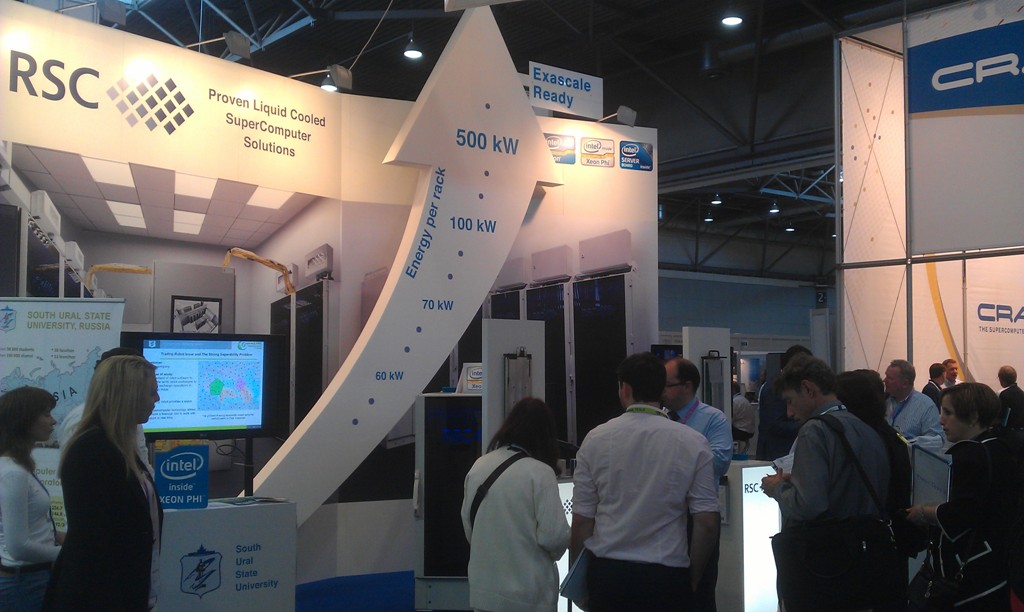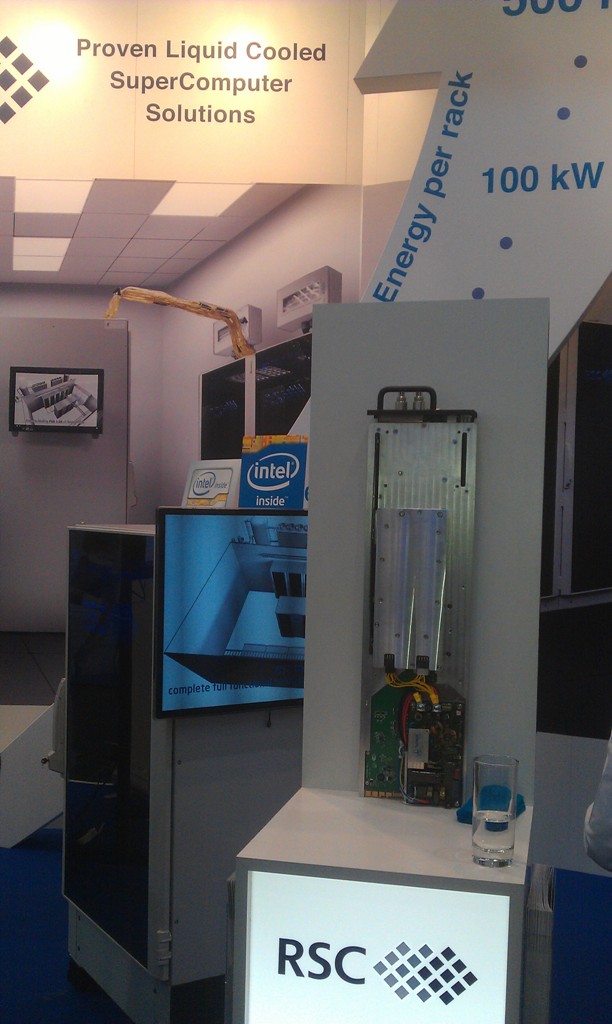Leipzig (Germany), International Supercomputing Conference. June 19, 2013. – RSC Group, the Russian leading innovative HPC solutions builder, announced at an International Supercomputing Conference (ISC’13) that it’s RSC™ Tornado supercomputing architecture with highly efficient liquid cooling has reached 200+ TFLOPS per rack milestone with Intel® Xeon Phi™ coprocessor new generation.
RSC Tornado architecture supports now the newest Intel Xeon Phi coprocessor 7120X within just launched Intel Xeon Phi coprocessor 7100 family. This new generation of Intel Xeon Phi coprocessors is designed and optimized to provide the best performance and offer the highest level of features, including 61 cores clocked at 1.23GHz, 16 GB of memory capacity support (double the amount available in accelerators or coprocessors today) and 1.2 TFLOPS of double precision performance.
Also RSC Tornado utilizes a new product added to the Intel Xeon Phi coprocessor 5100 family. Called the Intel Xeon Phi coprocessor 5120D, it is optimized for high density environments with the ability to allow sockets to attach directly to a mini-board for use in a blade form factor.
“Our innovative RSC Tornado liquid cooled architecture again delivered the high level of energy efficiency and world record computing (200+ TFLOPS per rack) and power (up to 100 kW per rack) density. This is a bright example of new technology level – 200 TFLOPS machine, that occupied a large hall just a few years ago, now fits into a one standard rack as well as you need only 5 computing racks based on RSC Tornado to get a supercomputer with 1 PFLOPS performance. ”, said Alexey Shmelev, Chief Operational Officer, RSC Group.
The use of an advanced liquid cooling system in RSC Tornado allows reaching industry’s highest computing density of 200+ TFLOPS per 80*80cm*42U rack or 156 TFLOPS/m3 so de-facto setting the new world record for х86 architectures. Such a high computing density is required for ExaFLOPS-range supercomputers, which will consist of hundreds of racks each consuming over 100kW of power. The unique power and performance density levels achieved by RSC Tornado architecture proves technical feasibility of building high-performance systems with required characteristics for ExaScale era.
Unique characteristics of RSC Tornado based solutions
The new stage in development of innovative RSC Tornado architecture for energy efficient data centers and supercomputing systems allowed RSC Group’s specialists to implement world's first direct liquid cooling for widely available Intel® Xeon® based standard server boards (from various manufacturers), initially designed for traditional systems with air cooling of electronic components, with the latest Intel Xeon Phi coprocessors. This is the third generation of RSC’s energy-efficient solutions for High Performance Computing, cloud environments and data centers.
Powerful solutions with high computing density based on RSC Tornado architecture with direct liquid cooling are designed to solve various customers’ needs. The product line includes RSC DCmicro (16 to 64 nodes), RSC DCmini (64 to 256 nodes) and RSC Data Center (from 2 high dense racks up to dozens of PFLOPS).
Among unique features of RSC Tornado architecture and solutions there are the following:
• Up to 128 х86 servers in a standard 42U rack 80х80х200 cm;
• High-density blade server design based on widely available boards;
• Record-breaking energy efficiency. The system allows achieving an industry-leading Power Usage Effectiveness (PUE) of less than 1.06 (the ratio of total amount of power used by a computer data center facility to the power delivered to computing equipment.). This means that maximum 5.7% of the consumed energy by a datacenter will be used for the cooling of the system;
• Record-breaking computing effectiveness ratio — more than 96% for Intel® Xeon® E5-2690 processors in LINPACK benchmark (Intel® Turbo Boost Technology is always on, which provides for clock speed gain of up to 400 MHz in LINPACK);
• Removal of over 100 kW of power from each rack using RSC’s unique liquid cooling design;
• Possibility to use Intel's top-performing server processors with heat dissipation of 135W, e.g. Intel Xeon E5-2690 Processor (2.9 GHz, 8 cores) and the newest highest performing Intel Xeon Phi coprocessors;
• High peak performance – over 47 TFLOPS per rack based on Intel x86 architecture with AVX Instruction set and up to 200 TFLOPS with the use of Intel Xeon Phi coprocessors;
• High density – 74 TFLOPS per square meter (using Intel Xeon only) and 312 TFLOPS per sq. m (with Intel Xeon Phi coprocessors);
• High scalability – up to PFLOPS level (dozens of racks);
• Cost effectiveness – operating cost reduction by 60 percent (energy cost saving due to RSC solution operation);
• Compact size – multifold datacenter floor area reduction comparing to traditional air-cooled installations;
• Fully integrated software stack for High Performance Computing – RSC BasIS optimized for high performance computing.





